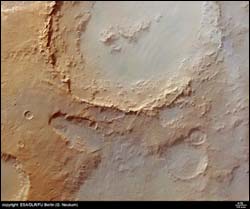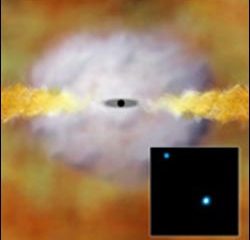This area deals with the fundamental laws and building blocks of nature and how they interact, the properties and the behavior of matter, and research into space and time and their structures.
innovations-report provides in-depth reports and articles on subjects such as astrophysics, laser technologies, nuclear, quantum, particle and solid-state physics, nanotechnologies, planetary research and findings (Mars, Venus) and developments related to the Hubble Telescope.

VLT Interferometer Studies the Inner Region of Circumstellar Discs [1]
One of the currently hottest astrophysical topics – the hunt for Earth-like planets around other stars – has just received an important impetus from new spectral observations with the MIDI instrument at the ESO VLT Interferometer (VLTI).
An international team of astronomers [2] has obtained unique infrared spectra of the dust in the innermost regions of the proto-planetary discs around three young

Dr Eddie Moxey of the University of Surrey recently gave a speech at the IEE seminar on the Changing Face of Robotics. His speech concentrated on the use of robotics in space.
The talk reviewed the past, present and future of the two main strands of space robotics research and development On-Orbit Servicing (OOS) and Planetary Exploration.
Since the deployment of the Canadarm, on the Space Shuttle, OOS has steadily developed from a fascinating research topic into a po

These images, taken by the High Resolution Stereo Camera (HRSC) on board ESA’s Mars Express spacecraft, show Crater Hale in the Argyre basin of the southern hemisphere of Mars.
The images show an area close to the northern rim of the Argyre basin, located at latitude 36° South and longitude 324° East. The image was taken with a ground resolution of about 40 metres per pixel during Mars Express orbit 533 in June 2004.
Slight periodic colour and brightness variations in

NASA’s Chandra X-ray Observatory has obtained definitive evidence that a distant quasar formed less than a billion years after the big bang contains a fully-grown supermassive black hole generating energy at the rate of 20 trillion suns. The existence of such massive black holes at this early epoch of the Universe challenges theories of the formation of galaxies and supermassive black holes. The Marshall Center manages the Chandra program.
NASA’s Chandra X-ray Observatory has

An Elizabethtown College professor has developed an embedded sensor that functions in cement much like a thermometer in the Thanksgiving turkey.
“The thermometer indicates if the turkey is done by measuring its internal temperature,” said Nathaniel Hager III, an adjunct faculty member in Elizabethtown’s physics and engineering department. “The embedded sensor does the same thing in concrete by monitoring how quickly water involved in the curing process is chemically combining wit

University of Kent astronomers Professor Glenn White, Dr Stephen Serjeant, Dr Toshi Takagi and collaborators, will be presented with the £10,000 Daiwa Adrian Prize 2004 at a Royal Society ceremony in London on Thursday 25 November.
The team have been awarded the prize in recognition of their pioneering work on the Japan-Anglo-Dutch ASTRO-F satellite, a powerful new space telescope which will make a map of the sky in far-infrared light.
Daiwa Adrian Prizes are trienni